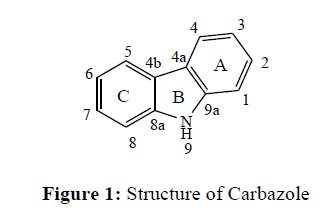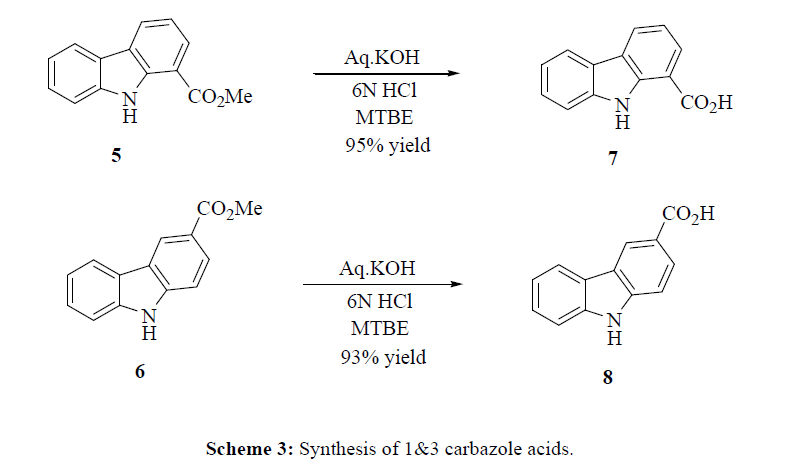Research Article - Der Pharma Chemica ( 2021) Volume 13, Issue 3
Synthesis of Carbazole-1&3-acids by using Suzuki coupling followed by Cadagon Reductive cyclization
Janardhanreddy Kanchani and M.C.S. Subha*M.C.S. Subha, Department of Chemistry, Sri Krishnadevaraya University, Anantapur, A.P, India, Email: mcssubha3@gmail.com
Received: 10-Mar-2021 Accepted Date: Mar 21, 2021 ; Published: 30-Mar-2021
Abstract
Using a Suzuki coupling followed by Cadagon reductive cyclization as a key steps, the first synthesis of 1-carboxylic acid carbazole has been achieved in 4 steps and in 65% overall yield. In the present work, this approach was applied to the total synthesis of carbazole alkaloids. This is the simple way to synthesise 9H-Carbazole-1-carboxylic acid and 9H-Carbazole-2-carboxylic acid.
Keywords
Miyaura coupling, Bispinacolatodiboron, TetrakisdiphenylphosphinoPd catalyst, Triphenyl phosphine, Cadagon reductive cyclization.
Introduction
Methyl carbazole-3-carboxylate (6) carbazole alkaloid was first isolated from naturally occurring Clausenaanisata [1], we report here a new and useful preparative method of synthesizing 1&3-carboxylic acid carbazoles which involves selective coupling between aryl bromides and aryl boronic esters. A large number of methodologies have been developed to construct the skeleton of substituted carbazole analogues. These include Fischer–Borsche synthesis [2], Graebe–Ullmann synthesis [3], and conversion of indole derivatives to carbazoles [4]. Although numerous synthetic approaches to substituted carbazoles have been reported, improvement is still needed to provide a step economic and region selective method. In the synthesis of carbazoles, region selective installation of appropriate substituents on the eight different available sites in the aromatic ring systems is a challenging task.Carbazoles are important targets for natural product synthesis. Carbazole (Figure 1) was isolated first from coal tar in 1872 by Graebe and Glazer [5].
One of the most common methods for carbazole synthesis involves the reductive cyclization of 2-nitrobiphenyl derivatives in the presence of suitable organophosphorus reagents [6]. This method is commonly referred to as the Cadogan cyclization and has a number of advantages, which include increased substrate scope and functional group tolerance, and more precise regiocontrol of functional group placement within the product. Many substituents are tolerated in this reductive cyclization, which represents the best procedure for the cyclization of the 2-nitrobiphenyls to the carbazole derivatives. The starting materials 2-nitrobiphenyl derivatives are easily prepared by the Suzuki-Miyaura cross-coupling of haloarenes with arylboronic acids.
Materials and Methods
Solvents and chemicals were purchased from commercial sources and used without further purification. 1H and 13C NMR spectra were recorded on Bruker 400-MHz instrument. Chemical shifts (δ) are reported in parts per million (ppm), and coupling constants (J) are reported in Hertz (Hz).
Splitting pattern are described as follows; br, broad; s, singlet; d, doublet; t, triplet; q, quartet; m, multiplet. Column chromatography was performed on silica gel (100-200 mesh). IR spectra were recorded on a PerkinElmer Spectrum 100 FTIR spectrophotometer as KBr pellets or with the neat product. Mass spectra (MS) were recorded on an API 2000 LCMS/MS AB Sciex spectrometer. Analytical thin-layer chromatography was carried out using E-Merck 60F254 aluminum-packed plates of silica gel (0.2 mm). Developed plates were visualized by using UV light or potassium permanganate solution.
Experimental Section
3-(4,4,5,5-Tetramethyl-[1,3,2]dioxaborolan-2-yl)-benzoic acid methyl ester (2)
To a stirred solution of 3-Bromobenzoic acid methyl ester (10 g, 46.5 mmol) in 1,4-dioxane (60 mL) under nitrogen atmosphere was added bis(pinacolato)diboron (17.68 g, 69.76 mmol), PdCl2(PPh3)2 (1.6 g, 2.32 mmol) and potassium acetate (9.12 g, 93.02 mmol) at room temperature, and the reaction mixture was stirred at 90°C for 5 h under nitrogen atmosphere. The reaction mixture was cooled to room temperature and diluted with ethyl acetate (100 mL). After the dilution, the mixture was filtered through a short pad of celite, and the filtrate was concentrated. The residue was purified by chromatography on a silica gel column (2% ethylacetate in hexane) provided compound 2as a off white solid (10.3 g, 82%), mp 93.2–95.8 °C:1H NMR (400 MHz, CDCl3) δ 8.47 (s, 1H), 8.13 (d, J = 8.0 Hz, 1H), 7.99 (d, J = 7.6 Hz, 1H), 7.46 (t, J = 7.6 Hz, 1H), 3.91 (s, 3H), 1.35 (s, 12H); 13C NMR (100 MHz, CDCl3)λ 167.15, 139.15, 135.83, 132.30, 129.57, 127.81, 84.09, 52.02, 24.87; IR (KBr) νmax 2981.23, 1719.88, 1292.95, 701.11 cm-1; MS: m/z 263.2 (M + H).
2'-Nitro-biphenyl-3-carboxylic acid methyl ester (4)
To a stirred solution of 1-bromo-2-nitrobenzene (3) (6 g, 29.7 mmol) in toluene (60 mL) was added Pd(PPh3)4 (1.71 g, 1.48 mmol), 3-(4,4,5,5-Tetramethyl-[1,3,2]dioxaborolan-2-yl)-benzoic acid methyl ester (2) (7.78 g, 29.7 mmol) and potassium carbonate (8.2 g, 59.4 mmol), and the resulting mixture was refluxed for 12 hours under nitrogen atmosphere. After cooling to room temperature, the solvent was evaporated. Purification of the residue by column chromatography (silica gel, 5% ethyl acetate in hexane) provided 4 as a white solid (6.49 g, 85%), mp 88.3–89.8 °C: 1H NMR (400 MHz, CDCl3) λ 8.09–8.07 (m, 1H), 8.01 (s, 1H), 7.94 (d, J = 8.4 Hz, 1H), 7.66 (t, J = 7.4 Hz, 1H), 7.54–7.49 (m, 3H), 7.45 (d, J = 7.6 Hz, 1H), 3.92 (s, 3H); 13C NMR (100 MHz, CDCl3) λ166.55, 148.95, 137.95, 135.53, 132.63, 132.34, 132.04, 130.68, 129.32, 129.10, 128.73, 128.71, 124.36, 52.26; IR (KBr) νmax 2950.06, 1723.93, 1525.43, 1246.61, 745.57 cm-1; MS: m/z 258.1 (M + H)+.
9H-Carbazole-1-carboxylic acid methyl ester (5) & 9H-Carbazole-3-carboxylic acid methyl ester (6)
To a stirred solution of 4 (5 g, 22.2 mmol) in 1,2-dichlorobenzene (50 mL) was charged triphenylphosphine (11.6 g, 44.4 mmol) at room temperature, and the reaction mixture was refluxed for 10 h. The reaction mixture was concentrated in vacuo, and the obtained residue was purified by column chromatography to provide products 57 (4% ethyl acetate in hexane) and 68 (6% ethyl acetate in hexane).
9H-Carbazole-1-carboxylic acid methyl ester (5)
(2.1 g, 48%), as a white solid, mp 136.7–138.4 °C (lit. mp. 135–137 °C) [7]; 1H NMR (400 MHz, CDCl3) λ 9.91 (s, 1H), 8.27 (d, J = 7.6 Hz, 1H), 8.09 (t, J = 6.6 Hz, 2H), 7.52-7.44 (m, 2H), 7.29 (t, J = 7.6 Hz, 2H), 4.03 (s, 3H); 13C NMR (100 MHz, CDCl3) λ 167.90, 140.07, 139.67, 127.37, 126.56, 125.49, 124.66, 122.47, 120.41, 119.97, 118.49, 111.63, 111.10, 51.98; IR (KBr) νmax 3409.47, 1682.36, 1262.56, 753.65, 725.05 cm-1; MS: m/z 226.1 (M + H)+.
9H-Carbazole-3-carboxylic acid methyl ester (6)
(2.1 g, 48%), as a white solid, mp 166.2–168.1 °C (lit.mp.168–170 °C) [8]: 1H NMR (400 MHz, CDCl3) λ 8.81 (s, 1H), 8.31 (br s, 1H), 8.14–8.11 (m, 2H), 7.46–7.42 (m, 3H), 7.31–7.27 (m, 1H), 3.97 (s, 3H); 13C NMR (100 MHz, CDCl3) λ 167.98, 142.33, 139.97, 127.46, 126.58, 123.32, 123.14, 122.92, 121.36, 120.64, 120.35, 110.94, 110.18, 52.00; IR (KBr) νmax 3410.89, 1717.12, 1248.37, 729.99 cm-1; MS: m/z 226.1 (M + H)+.
9H-Carbazole-1-carboxylic acid (7)
To a solution of 5 (1.5 g, 6.66 mmol) in water (25 mL) and ethanol (5 mL) mixture was added potassium hydroxide (0.75 g, 13.32 mmol) at 25 °C, and the reac tion mixture was refluxed for 5 h. The reaction mixture was filtered through celite and concentrated in vacuo. Silica gel col umn chromatographic purification of the obtained residue using ethyl acetate hexane (1:1) as an eluent provided product 7 as a whit e solid (1.33 g, 95%), mp 270.5 272.8 °C (ref.273 274 °C) [ 9]: 1 H NMR (400 MHz, DMSO d 6 ) λ 13.17 (br s, 1H), 11.34 (s, 1H), 8.41 (d, J = 7.6 Hz, 1H), 8.17 (d, J = 7.6 Hz, 1H), 8.04 (d, J = 2.6 Hz, 1H), 8.01 (d, J = 5.6 Hz, 1H), 7.46(t, J = 5.6 Hz, 1H), 7.29 7.19 (m, 2H); 13 C NMR (100 MHz, DMSO d 6 ) λ 168.38, 140.71, 139.51, 127.99, 126.60, 125.71, 124.64, 122.10, 120.61, 119.77, 118.45, 113.16, 112.70; IR (KBr) ν max 3438.88, 1670.86, 1266.14, 727.75 cm -1 ; MS: m/z 210.1 (M H).
9H-Carbazole-3-carboxylic acid (8)
To a solution of 6 (1.2 g, 5.33 mmol) in water (25 mL) and ethanol (5 mL) mixture was added potassium hydroxide (0.59 g, 10.65 mmol) at 25 °C, and the reaction mixture was refluxed for 4 h. The reaction mixture was filte red through celite and concentrated in vacuo. Silica gel column chromatographic purification of the obtained residue using ethyl acetate hexane (1:1) as an eluent provided product 8 as a white solid (1.05 g, 93%), mp 226.5 228.8 °C: 1 H NMR (400 MHz, DMSO d 6 ) λ 12.58 (br s, 1H), 11.66 (s, 1H), 8.78 (s, 1H), 8.25 (d, J = 8.0 Hz, 1H), 8.03 (d, J = 4.0 Hz, 1H), 7.56 (d, J = 8.4 Hz, 2H), 7.47 (t, J = 7.6 Hz, 1H), 7.25 (t, J = 7.4 Hz, 1H); 13 C NMR (100 MHz, DMSO d 6 ) λ 168.56, 142.88, 140.80, 127.41, 126.71, 122.95 , 122.63, 121.43, 121.04, 119.90, 111.79, 111.04; IR (KBr) ν max 3362.00, 1666.52, 1272.47, 722.80 cm -1 ; MS: m/z 210.1 (M H).
Results and Discussions
We synthesize (7) starting from 3-bromobenzoic acid methyl ester (1), it was treated with bis(pinacolato)diboron in 1,4-dioxane under nitrogen atmosphere to get 3-(4,4,5,5-Tetramethyl-[1,3,2]dioxaborolan-2-yl)-benzoic acid methyl ester (2) in 82% yield.
We carried out Suzuki-Miyaura cross-coupling reaction of compound 2 with 2-bromonitrobenzene in presence of Pd(PPh3)3 and potassium carbonate in toluene at reflux to get 2'-Nitro-biphenyl-3-carboxylic acid methyl ester (4) in 85% isolated yield. Synthetic route is shown in Scheme 1.
2-nitro biphenyl was further treated with triphenylphosphine in o-dichlorobenzene, two possibilities exist in 4, which gives a mixture of 5 and 6 (combined yields of 96%, 5/6, 1:1); 9H-Carbazole-1-carboxylic acid methyl ester (5) as a white color crystalline solid in 48% yield. 9H-Carbazole- 3-carboxylic acid methyl ester (6) in 48% yield as a white solid. Synthetic route is shown in Scheme 2.
Acknowledgments
One of the author M.C.S. Subha thanks UGC for providing BSR Faculty Fellowship.
References
- Ito C, Katsuno S, Itoigawa M et al., J Nat Pro. 2000, 63: p. 125-128.
- Fischer E and Jourdan F. Ber. Dtsch. Chem Ges. 1883, 16: p. 2241-2245.
- Graebe C and Ullmann F. Liebigs. Ann Chem. 1896, 291: p. 16-17.
- Crich D and Rumthao S. Tetrahedron. 2004, 60: p. 1513-1516
- Graebe C and Glaser C. Ber. Dtsch. Chem Ges. 1872, 5: p. 12-15.
- Cadogan JIG. Quart Rev. 1962, 16: p. 208-239.
- Julia M and Lenzi MJ. Bull Sot Chim Fr. 1962, p. 2263.
- Li WS, McChesney JD, El-Feraly FS. Phytochemistry. 1991, 30: p. 343-346.
- Akermark B, Eberson L, Jonsson E et al., J org chem. 1975, 40: p. 1365-1367.







